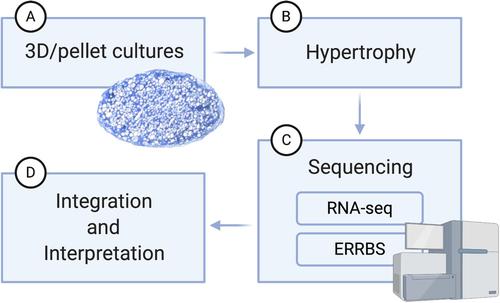当前位置:
X-MOL 学术
›
Ann. N. Y. Acad. Sci.
›
论文详情
Our official English website, www.x-mol.net, welcomes your
feedback! (Note: you will need to create a separate account there.)
Changes in DNA methylation accompany changes in gene expression during chondrocyte hypertrophic differentiation in vitro
Annals of the New York Academy of Sciences ( IF 4.1 ) Pub Date : 2020-09-25 , DOI: 10.1111/nyas.14494 Purva Singh 1 , Samantha G Lessard 1 , Piali Mukherjee 2 , Brennan Rourke 1 , Miguel Otero 1
Annals of the New York Academy of Sciences ( IF 4.1 ) Pub Date : 2020-09-25 , DOI: 10.1111/nyas.14494 Purva Singh 1 , Samantha G Lessard 1 , Piali Mukherjee 2 , Brennan Rourke 1 , Miguel Otero 1
Affiliation

|
During osteoarthritis (OA), articular chondrocytes undergo phenotypic changes that resemble developmental patterns characteristic of growth plate chondrocytes. These phenotypic alterations lead to a hypertrophy-like phenotype characterized by altered production of extracellular matrix constituents and increased collagenase activity, which, in turn, results in cartilage destruction in OA disease. Recent studies have shown that the phenotypic instability and dysregulated gene expression in OA are associated with changes in DNA methylation patterns. Subsequent efforts have aimed to identify changes in DNA methylation with functional impact in OA disease, to potentially uncover therapeutic targets. Here, we paired an in vitro 3D/pellet culture system that mimics chondrocyte hypertrophy with RNA sequencing (RNA-Seq) and enhanced reduced representation of bisulfite sequencing (ERRBS) to identify transcriptomic and epigenomic changes in murine primary articular chondrocytes undergoing hypertrophy-like differentiation. We identified hypertrophy-associated changes in DNA methylation patterns in vitro. Integration of RNA-Seq and ERRBS datasets identified associations between changes in methylation and gene expression. Our integrative analyses showed that hypertrophic differentiation of articular chondrocytes is accompanied by transcriptomic and epigenomic changes in vitro. We believe that our integrative approaches have the potential to uncover new targets for therapeutic intervention.
中文翻译:

DNA甲基化的变化伴随着体外软骨细胞肥大分化过程中基因表达的变化
在骨关节炎 (OA) 期间,关节软骨细胞经历表型变化,类似于生长板软骨细胞的发育模式特征。这些表型改变导致肥大样表型,其特征是细胞外基质成分的产生改变和胶原酶活性增加,进而导致 OA 疾病中的软骨破坏。最近的研究表明,OA 中的表型不稳定性和失调的基因表达与 DNA 甲基化模式的变化有关。随后的努力旨在确定 DNA 甲基化的变化对 OA 疾病的功能影响,以潜在地发现治疗靶点。这里,我们将模拟软骨细胞肥大的体外 3D/颗粒培养系统与 RNA 测序 (RNA-Seq) 配对,并增强亚硫酸氢盐测序 (ERRBS) 的减少表示,以识别经历肥大样分化的小鼠原代关节软骨细胞的转录组和表观基因组变化。我们在体外发现了与肥大相关的 DNA 甲基化模式变化。RNA-Seq 和 ERRBS 数据集的整合确定了甲基化变化与基因表达之间的关联。我们的综合分析表明,关节软骨细胞的肥大分化伴随着体外转录组和表观基因组的变化。我们相信,我们的综合方法有可能发现治疗干预的新目标。
更新日期:2020-09-25
中文翻译:

DNA甲基化的变化伴随着体外软骨细胞肥大分化过程中基因表达的变化
在骨关节炎 (OA) 期间,关节软骨细胞经历表型变化,类似于生长板软骨细胞的发育模式特征。这些表型改变导致肥大样表型,其特征是细胞外基质成分的产生改变和胶原酶活性增加,进而导致 OA 疾病中的软骨破坏。最近的研究表明,OA 中的表型不稳定性和失调的基因表达与 DNA 甲基化模式的变化有关。随后的努力旨在确定 DNA 甲基化的变化对 OA 疾病的功能影响,以潜在地发现治疗靶点。这里,我们将模拟软骨细胞肥大的体外 3D/颗粒培养系统与 RNA 测序 (RNA-Seq) 配对,并增强亚硫酸氢盐测序 (ERRBS) 的减少表示,以识别经历肥大样分化的小鼠原代关节软骨细胞的转录组和表观基因组变化。我们在体外发现了与肥大相关的 DNA 甲基化模式变化。RNA-Seq 和 ERRBS 数据集的整合确定了甲基化变化与基因表达之间的关联。我们的综合分析表明,关节软骨细胞的肥大分化伴随着体外转录组和表观基因组的变化。我们相信,我们的综合方法有可能发现治疗干预的新目标。











































 京公网安备 11010802027423号
京公网安备 11010802027423号